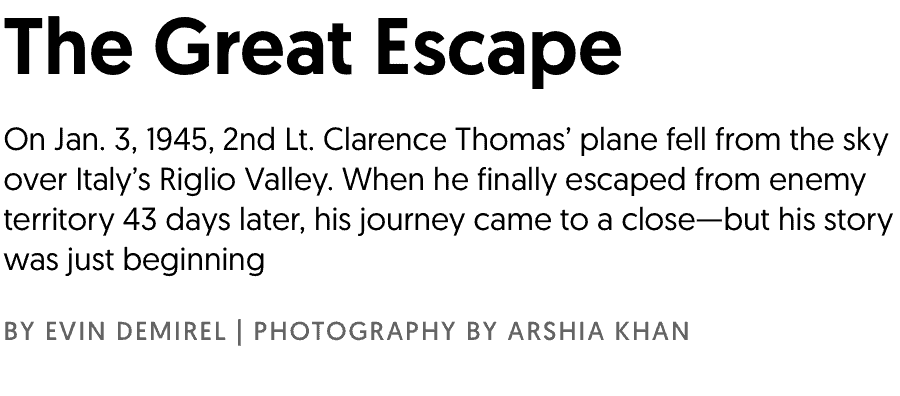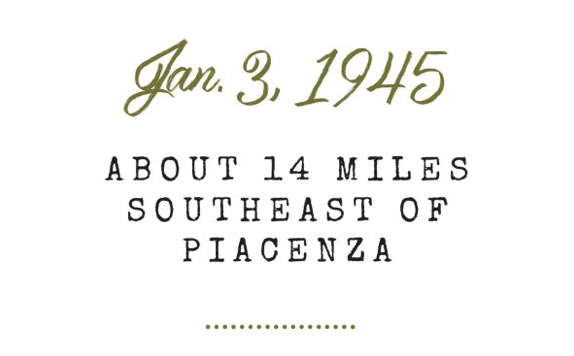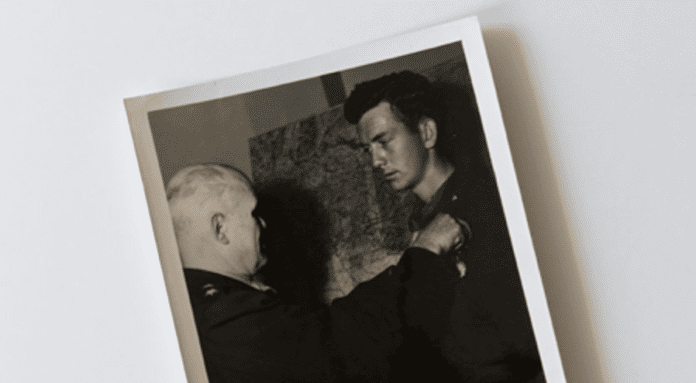-by Evin Demirel
I’m a history buff. When it comes to sports, I’ve written about all kinds of Arkansas heritage, from the dual-home stadium system, to the great Clyde Scott and Frank Broyles to a book on race relations and Arkansas history::
I’m also keen on the history of Arkansans in general. So when my friend Chris Thomas told me an amazing story about his own grandfather, who was shot over northern Italy in World War II and survived a harrowing escape from Nazis that sounded like something out of a movie, I knew I had to write it.
It’s easy to go through the motions and pay lip service to the “bravery” of our veterans on Veterans Day. I hope that the heart-pounding details in the story below reminds us all what true bravery looks like:


ALL THESE DECADES later, the map in Woody Thomas’ hands is still intact. Fading, to be sure, but usable. Issued to servicemen by the U.S. Army in 1943, its now dulled greens and blues display the contours of the hilly, wooded land of northwestern Italy between the towns of Pisa and Piacenza. Every last marsh, lake, canal, lighthouse, chapel, aqueduct, ford and forest is marked on a roughly 200-square-mile area.
In a later addition, but hardly less old, a line made by a marker, an uneven arc of dark forest green, clearly pressed down hard, runs up the middle of the wrinkled, weathered paper to the spot where Woody now stands. Yet that line, this map, was not needed in leading the 72-year-old here today, some 5,097 miles from his home in Little Rock. Instead, Woody’s journey was the work of many hands over many years. Those people stand here now—his sons, wife, daughter-in-law and Italian friends—but they’re not looking at the map. They’re studying the ground, they’re watching Woody’s face, and they’re listening to a stooped man recall his own past from more than 70 years before.
Pierino Casaliggi wasn’t yet 5 years old on that winter day in 1945 when he saw smoke billowing from a plane above the land near his hometown of Case Bassano in the Riglio Valley area, part of the larger Po Valley, a sprawling river basin that encompasses much of northern Italy. Pierino speaks only Italian, and Woody speaks English, but the language barrier hardly matters as the elderly Pierino rapidly recounts the details of what he witnessed in the last months of World War II.
He recalls seeing a fighter bomber falter, lurch and speed southward toward a field just a few hundred yards away. He points upward, tracing his tanned finger in the air. His eyes narrow. There. That’s where the plane skidded across the sky.
***

CLARENCE THOMAS DECIDED he wasn’t going down with this damn plane. Not now, just minutes after he’d completed a bombing and strafing mission hitting the railroad bridge at Calcinato. He’d been through far too much—fighting in North Africa, the invasion of Sicily, the advance on Rome—to meet his end just yet. Especially not here, 100 feet above the snow-capped Apennine mountaintops and descending far too quickly.
By this point, Thomas’ P-47 was shuddering and spewing oil. He radioed his lieutenant to relay the dire situation. They agreed: It was time to bail. Thomas unfastened his oxygen, safety belt and radio, severing his sole means of communicating with friends.
“That was the most lonesome feeling that I have ever experienced,” he’d later recall.
At 2:32 p.m., he opened the canopy and went over the right side of the plane with a .45-caliber service pistol in his shoulder holster and a trench knife tied onto his parachute. Seconds later, the plane tipped and crashed to the ground, immediately bursting into a fireball in the pasture below. For a few horrifying seconds, it seemed like Thomas would land in that fire, but the winds pushed him to a spot 200 feet away, where he crashed, miraculously unscathed.
Within minutes, as Thomas rolled his chute, a man holding a machine gun approached. Thomas asked, “Tu partisan?” and pointed to the red star on the man’s cap. The Italian partisans were World War II resistance groups fighting against the German occupants of Italy, its local socialist puppet regime and the Fascist Italian government. With shared enemies, the partisans and Americans were natural allies.
In Italian, the man affirmed he was one of the good guys. Clarence slapped him on the back and said “Eo Americano” to convey he was American. The new friends then walked arm in arm to a small farmhouse—the diminutive man carrying the chute, Clarence praising the partisans to the high heavens—where they met 20 or 30 men armed to the teeth. In Italian, Clarence asked “Where are the Germans?” They pointed down the nearby valley and said “Fascists.” Raising their hands, they pantomimed using binoculars.
The message was clear: Thomas had been seen.
***
For the rest of this feature, originally published in Arkansas Life, click on the link below:
***

***





